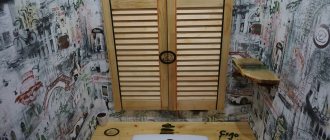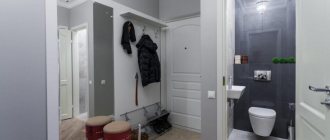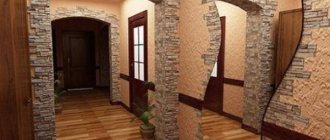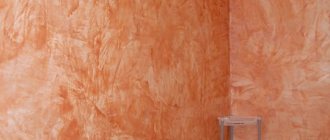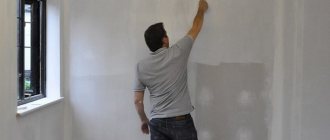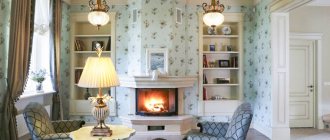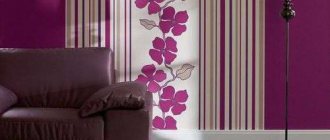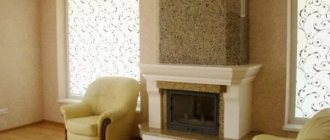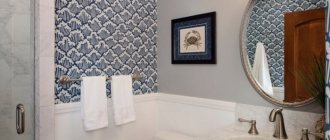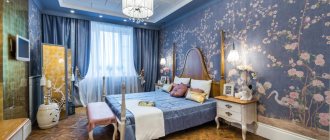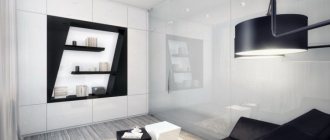Choosing wallpaper for the toilet
Liquid wallpaper in the toilet is a relatively new trend in modern renovation, which is gaining more and more popularity.
The increased demand for these products and their wide applicability are due to the maximum speed and maximum efficiency that can be achieved using this type of wallpaper.
Liquid wallpaper for the toilet is an ideal solution adopted in an effort to create a dynamic interior of the room.
The toilet room is the most problematic place in the apartment due to the abundance of pipes and high humidity.
Choice of colors
Using liquid wallpaper allows you to decorate the toilet in all possible colors and shades. But there are a few tips that you can follow to make the interior of your toilet beautiful and original:
- In a small toilet it is not recommended to use very dark colors, as they will visually further reduce it. Blue, purple and even black colors are best used in a spacious toilet that is combined with a bathroom. Here you can play with color and large bright accents and elements. In this case, the design will look very stylish and impressive;
- Using cold tones will not give a feeling of comfort and calm. Quite often, silver and bluish tones are used in the interior, which convey a feeling of cleanliness, but in order to make such a toilet more interesting, we recommend diluting it with lemon or bright blue stripes. Reviews for such color solutions are the best;
- An interesting solution is to decorate all the walls with plain wallpaper, and focus on one in the form of large decorative elements. It looks unusual and very stylish;
- Always try to maintain a balance between dark and light shades. For example, if you bought liquid wallpaper for the toilet in a dark color scheme, then the plumbing itself should be white or light. Pay attention to the photo;
- if the toilet room is small and low, use vertical stripes that will visually expand and lengthen it.
Types of wallpaper for the toilet
The prevailing use of ceramic tiles for finishing domestic premises leads to the relative high cost of repairs when you want a radical change in the interior. Despite all the undeniable functionality and ease of maintaining cleanliness, expensive tiles, which are always difficult to install, force owners to leave the interior of the toilet unchanged.
Wallpaper for the toilet in the apartment is not a new or innovative solution to the problem, which is becoming increasingly used. The reason for the popularity that toilet renovation with wallpaper is gaining is the new types developed by the construction industry.
Advances in polymer chemistry, which introduces new artificial components in the creation of building materials, make it possible to use economical options where previously it was considered unprofitable.
Wallpapering in the toilet has become a trend after the emergence of new categories of wall coverings that are resistant to high humidity, mold and mildew, which were previously considered a strong argument against walls with wallpaper in functional rooms. The opportunity to create a dynamic interior for people with a relatively small budget has attracted home enthusiasts to do their own renovations.
The familiarity and simplicity of the process contributed to this to a large extent. Construction stores offer a wide range of wall coverings, among which you can get confused when choosing wallpaper for your bathroom. Of the relatively new varieties for finishing a small functional space, you can consider the following:
- ceramic, (from porcelain stoneware), with increased resistance to moisture;
- vinyl (thick, which can be washed regularly);
- non-woven (waterproof, washable, applied using special antiseptic glue);
- fiberglass, easy to paint and resistant to wear;
- liquid (special powder, which is diluted and applied to the wall using a roller).
When purchasing wallpaper, you need to study the labeling.
Glass wallpaper
Fiberglass products are made by weaving thin strands of glass and paper. Initially, the canvases have a light gray color, which is subsequently painted over with water-based paint of any shade. Excellent performance characteristics, environmental friendliness, the possibility of repeated repainting, moisture resistance, fire safety - these are not all the positive qualities that such wallpapers have. This is an ideal option for a toilet in an apartment. True, if we talk about the financial component of the issue, then it should be noted that fiberglass products are much more expensive than previous analogues. But if you take into account the long service life of such a coating, then the costs are completely justified.
Using liquid wallpaper
Finishing toilet walls with liquid wallpaper is considered to be the most economical and requires minimal labor and time. This type of building material has gained great popularity not only due to its efficiency, but also due to its speed of application.
The fundamental novelty in the approach to its creation made it possible to design the coating without seams and joints, which primarily suffer from harmful and destructive influences. Finishing the walls with a material that provides a continuous layer made it possible to maintain a presentable appearance in the room for as long as possible.
Wallpapers of this category applied to the wall in the form of a diluted powder provide high sound insulation, low thermal conductivity, resistance to the harmful effects of fungi and moisture, and, as an additional bonus, high fire resistance because they do not burn.
Application process and its subtleties
Pasting a toilet with liquid wallpaper is not difficult and not very expensive. For 6.5 squares of wall you will need only 1 kg of dry mixture and primer. If you add decorative filler, then even less composition will be required.
You just need to first inquire at a hardware store about whether the properties of the brand you are purchasing allow you to introduce foreign components into it, and purchase the appropriate variety.
Psychologists do not recommend pasting functional units with aggressive colors, but in the assortment of powder mixtures you can find almost any shade of the visible spectrum, so we glue the one that is more compatible with the plumbing and the design of the toilet room.
These are not photo wallpapers that can get boring in a short time, despite the fact that several hours have been spent on them. A wall coated with a liquid powder mixture gives an unobtrusive color dominant, which is easy to change if the choice turns out to be unsuccessful, or if the color scheme is boring.
About freedom of choice and the benefits of wallpaper
The toilet and bathroom are places where a person spends relatively little time. But it is their finishing and design that is given special importance. A correctly designed place for performing natural needs from an aesthetic and physiological point of view helps a person throughout the whole day. Doctors believe that visiting the toilet promotes good health if it is comfortable and cozy. A person improves the process of digestion and metabolism if he does not feel any discomfort, removing toxins and waste from the body.
Everyone has the right to decorate a bathroom in their own home in the way they consider most comfortable and convenient, but the familiarity of an established interior can sometimes be depressing. That is why renovations in an apartment begin with the bathroom and often end there due to lack of time.
If you need dynamics in changing the interior, there is no point in using expensive materials, the price of which will subsequently serve as an obstacle to changing the decor. Wallpaper is the best option for repairs, which industrial chemistry has made as variable and functional as possible. A good owner can only make the right choice and begin work. For more information about finishing the toilet, watch this video:
The times when renovations involved only paper wallpaper, not always of good quality, are irrevocably a thing of the past, thanks to the latest technologies. Today it is one of the most used and promising building materials, inexpensive and extremely easy to use.
Source: moyastena.ru
We apply liquid wallpaper in the bathroom and toilet with our own hands: bathroom design options (+13 photos)
It is no secret that with the development of modern innovative technologies, repairs in the 21st century are acquiring other, more advanced and technological forms, offering people more and more new materials and techniques for performing work.
Liquid wallpaper is one of the favorite new products that has been appreciated by consumers.
This environmentally friendly cellulose mixture leaves no one indifferent: it looks luxurious on the walls and creates an interior for every taste. And material costs are minimal.
How to remove wallpaper correctly?
Now we will look at how to properly remove washable wallpaper. The first step is to wet them generously with water and wait 5-10 minutes until they dry a little.
Then take a regular metal spatula and begin to carefully pry them off. Please note, when working with a spatula, use liquid soap.
Bathroom decoration
Preparing the surface for applying liquid wallpaper in the bathroom is no different from similar work in other rooms. The method and technology are the same. The old coating is removed, the surface is puttied and primed.
Everything will go very easily if you have wallpapered before. If before the renovation began there were ceramic tiles in the bathroom, then this process promises to be labor-intensive. But don't be upset. The most important thing is ahead - applying liquid wallpaper. After all, this is exactly what you wanted!
Following the instructions on the package, prepare liquid wallpaper for the bathroom and leave the mixture to mature for the specified amount of time.
After the specified time has passed, mix the material again and add a little water. Apply liquid wallpaper with a plastic trowel. You won't find a more convenient tool for this kind of work.
Liquid wallpaper is best applied from corner to corner of the wall, easily smoothing the mixture with a trowel.
Liquid wallpaper: disadvantages, reviews without retouching
Before planning a renovation, read reviews about liquid wallpaper. This will help you take off your rose-colored glasses and really look not only at the features of the material, but also at your own capabilities. We have selected for you several truthful reviews from those who made liquid wallpaper with their own hands and appreciated them in practice (the authors' spelling has been preserved):
Pay attention to reviews about the pros and cons of liquid wallpaper. Often their benefits are easily disputed by practitioners. Here is an example of such a review:
Paper plaster is used not only for covering walls. Some people also apply this finish to ceilings. If the room is located on the top floor of the building, this technique is justified. Additional ceiling treatment will keep the room warm. But not everyone thinks it's a good idea to apply liquid wallpaper to ceilings. Photos and reviews sometimes indicate extremely unsuccessful experiments. And, by the way, inviting outside specialists does not guarantee a successful result. Here is one such story:
Applying a protective coating to liquid wallpaper
The next stage of working with liquid wallpaper is coating with a protective layer of varnish. After applying the liquid wallpaper to the surface, give it time to dry.
We choose a clear acrylic-based varnish. In the future, it will protect the material from getting wet and make the surface matte. The varnish should be applied with a wide brush or roller.
By the way, the use of liquid wallpaper does not require pre-treatment of the wall surface, since the cellulose mixture perfectly eliminates minor defects and minor irregularities on the walls of the room.
You just need to apply a primer to the walls. This will save not only your time, but also money.
A detailed article will tell you how to install corrugation on a hood without outside help.
Read about sockets with a timer in this article. Modifications/types of electrical outlets, features of self-installation.
What is liquid wallpaper and its varieties
There is a version that liquid wallpaper was first invented in France and its appearance was historically associated with Charles VII. Allegedly, it was in the castle he captured that the walls were first covered with a mixture of crushed silk and flour. The king was impressed by this original idea of the masters and this technology was used in other palaces.
The use of this material can give an ordinary room a palace luxury
In fact, it would be correct to call the material paper plaster, and not wallpaper, but that’s the way it is. So, liquid wallpaper - what is it? This is a crumbly dry multicomponent mixture, which is packaged in bags by weight, and for application diluted with water or an adhesive composition.
Liquid wallpaper contains the following components:
- Cotton or cellulose fibers. This component makes up 90 percent of the material. Recycled raw materials can be used for the mixture. The waste from textile and woodworking production and waste paper is used.
- Decorative elements. Their main task is to decorate and give a special relief to the coating. For this purpose, sequins, silk fiber, small beads, wood chips or threads and various dyes are used.
- Adhesive base. The binder composition can be PVA, regular wallpaper glue or bustilate, paste. Natural compounds, non-toxic and inexpensive are welcome.
- Additional additives. To prevent mold fungi and pathogenic bacteria from multiplying on the surface of the material, antiseptics are added to paper plaster. If you plan to use the coating in rooms with high humidity, it is advisable to coat it with varnish.
The color palette of the material is very rich. You can choose a plain or variegated coating, combine different colors in patterns and relief coating
Table 1. Types of material
Wall decoration in the toilet
When starting finishing work in the toilet, many people have problems with finishing the walls. This is most often due to a very small area of the room. With such a small square footage, most often the owners also end up with very uneven walls.
Preparing walls for applying liquid wallpaper in the toilet is very simple. To do this, it is enough to putty the surface. After this very simple procedure, we clean the surface with sandpaper. Then we prime the walls twice with a special primer for liquid wallpaper or use acrylic.
When processing walls, you can encounter various metal objects that may cause rust stains in the future. We paint such parts of the walls with white oil paint.
Preparing the base for wallpapering
First, let's figure out how to prepare the surface for liquid wallpaper, since this option for wall decoration requires special preparation.
1. First of all, it is necessary to clean the wall of old materials (putty, wallpaper, paint, etc.) and any contaminants that will certainly appear as a result of contact with water.
2. If there are large cracks, holes, holes and any other irregularities in the walls, they are sealed with a spatula and putty. This is necessary in order to reduce the wasteful consumption of wallpaper mixture. If deep recesses are not eliminated first, sudden changes in the thickness of the decorative layer will be very noticeable on the dried wall.
3. In cases where there are too many different defects on the surface, the entire wall is covered with an even layer of gypsum putty.
4. After leveling the base, it should be treated with a standard primer. This work is done 3 times every three hours.
5. Immediately before applying liquid wallpaper, the entire surface is covered with a special putty or white water-based paint.
As for rolled materials, the process of preparing walls is slightly simpler. The surface is also primed, leveled using finishing putty, and then sanded. A flat wall is re-treated with a primer. After the base has completely dried, you can begin gluing wallpaper.
Combine liquid wallpaper with tiles
When renovating a bathroom and/or toilet, many people choose a combined wall decoration option - liquid wallpaper + tiles. For example, part of the wall area can be decorated with ceramics, and the other with liquid wallpaper.
As you can see, to hang liquid wallpaper in a toilet or bathroom you do not need to have any special practical finishing skills.
Read about the characteristics of polyvinyl acetate water-based paint - in detail about modern paints for painting walls.
Read about armored film for windows here: design modifications and features of using protective films.
Review: Liquid wallpaper Silk Plaster - Beautiful, pleasant, and has stood the test of time IN THE BATH!)
How pleasant it is to remember the renovation when it has long been completed, the dust and passions have settled, and the result was a success!
Already 2.5 years ago, a natural disaster called “overhaul” occurred in our house. The bath and toilet took the brunt of the damage. To break it is to break it. In the toilet, everything was redone, and in the bathroom, the walls painted above the tiles became dirty, stained and even scratched somewhere by the “handy” workers.
When choosing options on how to fix it, I didn’t want to paint it again; choosing the right tile and adding a couple of rows turned out to be problematic; But visually and according to the description, I liked the new material “liquid wallpaper” that I saw in the store.
Before buying, we read how to work with it - we seem to be able to handle it. And the consultant at the store encouraged me. Only my parents were full of pessimism, who believed that: - we ourselves can’t do it, - if we can, it will fall off, - if it doesn’t fall off, it will look bad.
Well, about “look” it’s subjective. For example, I like it—the material is warm, it was easy to choose the color, it’s voluminous and cute, in my opinion. For your perspective, see the photo below.
Here's the transition from tile to wallpaper.
As far as I remember, the wall was pre-primed. I used to think that “priming” was something complicated, like laying a road—probably in consonance with the word “soil.” It turned out that it was just a matter of running a special liquid over the wall.
The wallpaper itself needs to be soaked first, everything is written there, like 12 hours for swelling. The composition of the wallpaper is a mixture of fibers, as it is written on the package, silk and cellulose, some kind of binder and even minerals. In fact it is. as my husband said, it was as if the remains of all sorts of things were thrown into a bag and sold to us)) The video (sorry, not of very high quality) shows the process of soaking and, I would say, softening the material)) A pleasant process, as well as the subsequent work with it .
The next day our, dare I say it, creativity began. A specialist would probably be able to seal walls of such a small volume in half an hour of soulless professional work with a spatula. We, working without experience and with soul, put more than 2 hours of joint efforts on our walls. But! we enjoyed it, never quarreled, leveled it down to the millimeter, felt every inch of the wall with our hands (yes, the spatula smeared a lot and left gaps, in the end we leveled the wallpaper with our hands, immediately correcting it if somewhere it didn’t work out or turned out bad) . The disadvantage of this approach is that the volume of wallpaper, which should have been sufficient in reserve, was quickly sold out and we could barely stretch the remainder onto a less visible wall. We probably took more than the average calculated amount.
After the wallpaper had completely dried—one or two days—the husband coated it three more times with a special varnish to protect it from moisture, but still had a bath. But the result exceeded our and our parents’ expectations and looks exactly the same after 2.5 years as it did immediately after the renovation.
I recommend it to creative and patient people!)
Features of finishing the toilet room
To many, this idea may seem completely impractical, but this is only at first glance. Wallpapering the toilet room is a good option for many reasons, which can become not just a worthy alternative to tiles, but also an interesting and original design solution in the apartment.
But you should understand that in the bathroom there is high humidity and frequent temperature changes, so not all wallpapers will fit in this room, but only those that have a certain set of characteristics:
- It is not recommended to decorate the toilet room with simple single-layer paper, because it will soon get wet.
In addition, due to the small size of this room, frequent scratches are inevitable, as a result, even attractive wallpaper that is not adapted to the given conditions will soon have to look for a replacement.
- The toilet must be decorated with wallpaper that is moisture resistant, otherwise due to dampness it will simply begin to peel off from the walls. And the material, which is not afraid of moisture, will serve for a long time. At the same time, you won’t have to avoid wet cleaning in the toilet, which is necessary to prevent fungus and mold from appearing on the wallpaper.
- Wallpaper should not be too thin, as it will quickly wear off due to frequent mechanical damage, but it should not be too dense either. A material that is too heavy due to humidity will begin to move away from the walls under the pressure of its own weight, so it is better to give preference to lighter, but no less durable models.
- It is important to choose the right texture and shade of wallpaper so that it looks harmonious in the toilet room. Now stores offer a huge number of colors that will allow you to create an interesting and original design in your bathroom.
- Before you start gluing wallpaper during renovation, you need to prepare the toilet room: hide all the pipes, carry out communication before this. But the plumbing must be installed after the wallpaper has been hung, otherwise it will significantly interfere with the process.
It is worth considering the features of this room in order to choose the right wallpaper material, which will be not only practical, but also beautiful.
Advantages and disadvantages
The advantages and disadvantages of wallpaper for the toilet should be considered separately, since the conditions of the room differ from usual ones and have more requirements for the material.
| pros | Minuses |
| Aesthetic appearance | Limited material selection |
| Wide variety of colors | Short service life (compared to tiles) |
| Budget-friendly finishing option compared to tiles | High risk of mold and mildew |
| Using a drawing you can visually increase the area of the room | |
| Finishing and dismantling work is much easier |
In the photo on the left is a toilet decorated with 3D wallpaper in a tropical style. The room seems larger due to the unusual lighting.
The photo shows the toilet design in black and white. The decoration is made with wallpaper with a large pattern.
Which wallpaper is best?
There are many types of wallpaper that are suitable for the toilet room. It is worth starting from individual preferences and characteristics of the bathroom.
Washable
Many people choose washable wallpaper, in other words, sheets of paper on which one or another design is applied. The surfaces of the material are protected with a waterproof film, thanks to which moisture will not cause them to peel off from the walls. This model has a low cost, and sticking it on the walls will not be difficult, which is a significant advantage. With a protective film, the wallpaper will not be afraid of dust, dirt, mold and mildew. This model has advantages over the usual paper one; it will last much longer.
With synthetic base
You can hang wallpaper that has a synthetic base. That is, they consist of textile fabrics glued to thin foam rubber. This finishing material has undoubted advantages: it is environmentally friendly and has good sound and heat insulation. Instead of wet cleaning, you need to clean this wallpaper with a vacuum cleaner.
Vinyl
Some people prefer vinyl wallpaper. They will not be cheap to repair, but this material is moisture resistant, so it will not be afraid of deformation from dampness and temperature changes. Gluing them is not difficult, you just need to take into account the special choice of glue that is suitable for heavy material. Vinyl wallpaper will not bubble or peel off the wall, its appearance will not change for a long time, it will serve for ten years or even longer.
Glass wallpaper
Another interesting option is glass wallpaper, which is made from fiberglass (paper and thin glass threads). The canvas itself is light gray, but then it is painted over with paint in different shades. These wallpapers are quite expensive, but they are worth it considering their characteristics. They are durable, so they will not wear off due to any damage for a long time (for this reason, they are used not only for bathrooms in apartments, but also for public toilets).
The fiberglass canvas will almost not absorb wet fumes, they are not afraid of chemicals and even aggressive substances (powders, solvents, etc.), so you can safely use a variety of detergents to clean them.
Fiberglass models have environmental and fire protection properties. Neither water nor fire will harm them. Another advantage is that this material can be painted in any color, which will allow you to turn interesting interior ideas into reality.
Source: dekoriko.ru
How to remove wallpaper
If you need to change the coating, you must first remove the old one. Regular wallpaper is quite easy to remove. The liquid option may cause some difficulties. If they are not coated with a special protective varnish, then the coating can be removed using ordinary water or a prepared solution. It is important what kind of glue was used for cladding. For example, you can prepare a solution for PVA at home yourself.
If the choice falls on water, it is recommended to heat it before use. To prepare a special solution, just add a small amount of laundry soap, shampoo or hair conditioner to the water.
The prepared solution or water is applied to the surface using a brush. For hard-to-reach areas, it is recommended to use a sponge. It is necessary to remove the lining after the liquid penetrates deeply into the structure of the material. If necessary, it is permissible to wet the surface several times. Particular attention is paid to cleaning corners.
Using the described method, you can remove standard liquid wallpaper. If they are coated with a protective varnish, they will be more difficult to remove. To do this, you will need a drill with a special attachment and personal protective equipment. You can use a grinding machine. You need to work slowly, taking regular breaks. The process is lengthy and requires a lot of effort and time. Using the selected tool, the layer of varnished liquid wallpaper is removed until it disappears completely.
It is worth noting that the surface on which the cladding is applied is important. A wooden or concrete base requires a special approach when dismantling such cladding. The surface is easy to damage. To remove material from wooden walls, you need to use an industrial hair dryer. To remove wallpaper from concrete walls, it is recommended to use a sanding machine equipped with a suitable attachment.
You can also use modified glue. It is diluted with water and applied to the surface. After 30 minutes, remove the lining with a spatula. After removing the old coating, it is definitely recommended to putty the entire area.
Liquid wallpaper is an original and modern material. Thanks to the wide range, they allow you to experiment in room design. You can choose the right option for any style. The products have many advantages. The plastic material hardens on the surface without forming seams, allowing you to create a feeling of integrity in the room. In order for the cladding to turn out to be of high quality, it is important to properly prepare the rough surface and choose the right spatulas for the job. The product does not require special care, which adds to its advantages.
Wallpaper for the toilet
Beautiful wallpaper for the toilet is a practical finishing option, along with tiles or painting. This type of arrangement of a toilet room has a number of advantages.
Combination of liquid wallpaper with other types of wall decoration
Modern interiors often involve a combination of finishing materials. According to experts, silk plaster will go well with:
- decorative metal coatings;
- decorative stone;
- PVC panels;
- laminate;
- clapboard (imitation of logs or timber);
- glass;
- tiles.
Finishing the toilet room: what to consider?
Usually, when decorating walls in the toilet and bathroom, tiles or painting with water-based paint are used. These two options are quite labor-intensive and expensive. Ceramic tiles, although only a few square meters are required in this case, are expensive in themselves. Tile adhesive and the work of a professional installer are also not cheap. For painting, you need to prepare an even and smooth layer using plaster and putty.
Any type of wallpaper is quite unpretentious to paste. The main condition is smooth walls, but there is no need to level them to a shine using finishing putty.
The surface may remain a little rough, but the wallpaper glue itself will smooth it out.
When choosing wallpaper for decorating toilet walls, apartment owners receive the following advantages:
- The main significant advantage is the low cost of the material. Almost any type of wallpaper, except the most exclusive vinyl and embossed ones, will cost much less than tiles and plastic panels.
- The work itself can be done independently, in a few hours. Even if you order the repairs from someone, it will cost much less than laying tiles, plaster, putty and painting.
- A huge selection of all kinds of colors, patterns, designs. Tiles and other materials do not have such variety. Today it is even possible to order your own drawing or design.
- Ecological purity of most species. Wallpaper does not contain substances harmful or hazardous to health.
- The wall covering work itself is relatively clean; after it there is not a lot of dirt left behind, such as, for example, from tile adhesive or plaster.
- If there is any defect, it is easy to eliminate it by gluing it with a small piece.
But it is worth considering some of the disadvantages of wallpapering in the toilet:
- This material is less reliable than tile. In addition, unexpected leaks can often occur in the bathroom, and then the wallpaper becomes unusable.
- Wallpaper is intended for large areas of flat surface. There are many hard-to-reach places in the toilet, which makes gluing them difficult.
- Wallpaper is less durable than paint or tiles; low-quality types can fade quickly.
Wallpaper for the toilet is the cheapest type of material that does not require complex construction work. Almost any owner can paste over several square meters of walls. And many varieties of colors and patterns give you the opportunity to choose an interior to suit every taste.
Since there is high humidity in the toilet and bathroom, not all types of wallpaper are suitable.
Source: stroy-podskazka.ru
For DIYers: how to make liquid wallpaper with your own hands
Some craftsmen actually make this type of coating with their own hands. How to make liquid wallpaper at home? It would seem that the task is not difficult. Shred paper or fabric with scissors, add glue and glitter - and you're done. You can find many instructions on how to make liquid wallpaper with your own hands. Manufacturing proportions and original ideas are not difficult to find on numerous websites.
But don’t rush to take up the scissors. Imagine that to treat one square meter of wall you will need 300 grams of dry mixture, but for the entire wall? Even if it takes up a modest 12 squares, you will have to cut at least three and a half kilograms of paper. Take a stack of newspapers of this weight and imagine the amount of work. Please note that each particle should be only a few millimeters in size. If you don't have a special automatic cutting tool, you'll end up with scissor calluses. And another argument against: you can’t use magazines and newspapers for cutting. Newspapers will leave black streaks of printing ink on the walls, and the glossy paper of magazines does not absorb glue and moisture. You will have to buy special paper, quite soft and loose. Do you want to cover your walls with toilet paper? Hardly. Then she doesn't fit.
